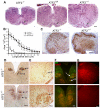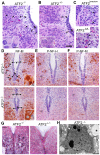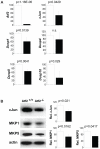Loss of ATF2 function leads to cranial motoneuron degeneration during embryonic mouse development
- PMID: 21533046
- PMCID: PMC3080913
- DOI: 10.1371/journal.pone.0019090
Loss of ATF2 function leads to cranial motoneuron degeneration during embryonic mouse development
Abstract
The AP-1 family transcription factor ATF2 is essential for development and tissue maintenance in mammals. In particular, ATF2 is highly expressed and activated in the brain and previous studies using mouse knockouts have confirmed its requirement in the cerebellum as well as in vestibular sense organs. Here we present the analysis of the requirement for ATF2 in CNS development in mouse embryos, specifically in the brainstem. We discovered that neuron-specific inactivation of ATF2 leads to significant loss of motoneurons of the hypoglossal, abducens and facial nuclei. While the generation of ATF2 mutant motoneurons appears normal during early development, they undergo caspase-dependent and independent cell death during later embryonic and foetal stages. The loss of these motoneurons correlates with increased levels of stress activated MAP kinases, JNK and p38, as well as aberrant accumulation of phosphorylated neurofilament proteins, NF-H and NF-M, known substrates for these kinases. This, together with other neuropathological phenotypes, including aberrant vacuolisation and lipid accumulation, indicates that deficiency in ATF2 leads to neurodegeneration of subsets of somatic and visceral motoneurons of the brainstem. It also confirms that ATF2 has a critical role in limiting the activities of stress kinases JNK and p38 which are potent inducers of cell death in the CNS.
Conflict of interest statement
Figures









Similar articles
-
Sensitisation of c-MYC-induced B-lymphoma cells to apoptosis by ATF2.Oncogene. 2014 Feb 20;33(8):1027-36. doi: 10.1038/onc.2013.28. Epub 2013 Feb 18. Oncogene. 2014. PMID: 23416976
-
JNK-mediated activation of ATF2 contributes to dopaminergic neurodegeneration in the MPTP mouse model of Parkinson's disease.Exp Neurol. 2016 Mar;277:296-304. doi: 10.1016/j.expneurol.2015.10.010. Epub 2015 Oct 26. Exp Neurol. 2016. PMID: 26515688
-
Caspase-3 is a target gene of c-Jun:ATF2 heterodimers during apoptosis induced by activity deprivation in cerebellar granule neurons.Neurosci Lett. 2011 Nov 14;505(2):76-81. doi: 10.1016/j.neulet.2011.09.060. Epub 2011 Oct 1. Neurosci Lett. 2011. PMID: 21996423
-
The activating transcription factor 2: an influencer of cancer progression.Mutagenesis. 2019 Dec 19;34(5-6):375-389. doi: 10.1093/mutage/gez041. Mutagenesis. 2019. PMID: 31799611 Free PMC article. Review.
-
ATF2: a transcription factor that elicits oncogenic or tumor suppressor activities.Cell Cycle. 2008 Aug;7(15):2341-5. doi: 10.4161/cc.6388. Epub 2008 Jun 17. Cell Cycle. 2008. PMID: 18677098 Review.
Cited by
-
DNA Damage Response Is Involved in the Developmental Toxicity of Mebendazole in Zebrafish Retina.Front Pharmacol. 2016 Mar 14;7:57. doi: 10.3389/fphar.2016.00057. eCollection 2016. Front Pharmacol. 2016. PMID: 27014071 Free PMC article.
-
Aberration of the modulatory functions of intronic microRNA hsa-miR-933 on its host gene ATF2 results in type II diabetes mellitus and neurodegenerative disease development.Hum Genomics. 2020 Sep 29;14(1):34. doi: 10.1186/s40246-020-00285-1. Hum Genomics. 2020. PMID: 32993798 Free PMC article.
-
SETDB1 acts as a topological accessory to Cohesin via an H3K9me3-independent, genomic shunt for regulating cell fates.Nucleic Acids Res. 2022 Jul 22;50(13):7326-7349. doi: 10.1093/nar/gkac531. Nucleic Acids Res. 2022. PMID: 35776115 Free PMC article.
-
THAP and ATF-2 regulated sterol carrier protein-2 promoter activities in the larval midgut of the yellow fever mosquito, Aedes aegypti.PLoS One. 2012;7(10):e46948. doi: 10.1371/journal.pone.0046948. Epub 2012 Oct 4. PLoS One. 2012. PMID: 23056538 Free PMC article.
-
Dysfunctional Homozygous VRK1-D263G Variant Impairs the Assembly of Cajal Bodies and DNA Damage Response in Hereditary Spastic Paraplegia.Neurol Genet. 2021 Sep 2;7(5):e624. doi: 10.1212/NXG.0000000000000624. eCollection 2021 Oct. Neurol Genet. 2021. PMID: 34504951 Free PMC article.
References
-
- Herdegen T, Leah JD. Inducible and constitutive transcription factors in the mammalian nervous system: control of gene expression by Jun, Fos and Krox, and CREB/ATF proteins. Brain Res Brain Res Rev. 1998;28:370–490. - PubMed
-
- Gupta S, Campbell D, Derijard B, Davis RJ. Transcription factor ATF2 regulation by the JNK signal transduction pathway. Science. 1995;267:389–393. - PubMed
Publication types
MeSH terms
Substances
Grants and funding
LinkOut - more resources
Full Text Sources
Molecular Biology Databases
Research Materials

